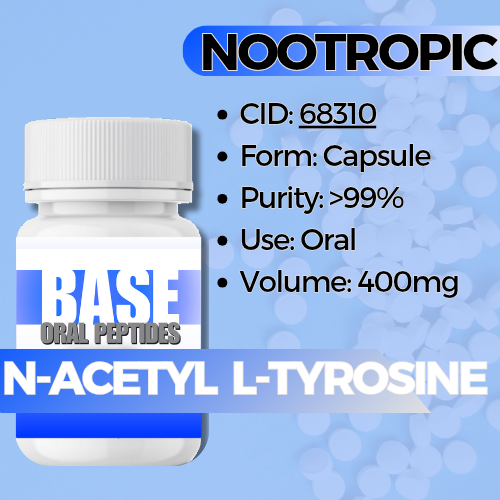NALT: N-Acetyl L-Tyrosine
NALT: N-Acetyl L-Tyrosine
Base Peptides are intended for licensed medical professionals and experienced researchers. Reconstitution required. Dosing and use instructions are not provided.
Couldn't load pickup availability
N-Acetyl L-Tyrosine (NALT) — Enhanced Tyrosine Derivative
N-Acetyl L-Tyrosine (NALT) is a more stable, acetylated form of the amino acid L-Tyrosine. It’s studied for its potential to support cognitive performance, stress resilience, and catecholamine synthesis—especially during demanding physical or mental activity.
- Synonyms: NALT, N-Acetyl L-Tyrosine
- CAS No.: 537-55-3
- Formula / MW: C11H14N2O4 • ~238.24 g·mol⁻¹
- Class: Acetylated amino acid (Tyrosine derivative)
- Acts as a precursor to dopamine, norepinephrine, and epinephrine — key neurotransmitters tied to motivation, focus, and alertness.
- The acetylation increases water solubility and potential stability versus plain L-Tyrosine, which may improve bioavailability in some contexts.
- Used to study cognitive and stress responses in models involving sleep deprivation, high workload, or environmental stress.
- To evaluate catecholamine precursor dynamics under stress or fatigue conditions.
- To measure cognitive resilience and executive function under load (e.g., military, aviation, or endurance models).
- To compare metabolic handling and neurotransmitter output vs. L-Tyrosine and related amino acid derivatives.
Key Study Themes — What’s Typically Observed
Stress & Cognitive Performance
- Endpoints: Working memory, reaction time, task accuracy, stress hormones.
- Typical findings: Improved accuracy and cognitive control under acute stress (e.g., cold exposure, multitasking, sleep loss).
- Why it matters: Suggests support of dopamine and norepinephrine synthesis during high demand.
Neurotransmitter & Metabolic Effects
- Endpoints: Plasma catecholamines, tyrosine kinetics, stress-response markers.
- Typical findings: Increased precursor availability; possible protection against neurotransmitter depletion under stress.
- Design notes: Conversion efficiency can vary; sometimes compared directly with plain L-Tyrosine in bioavailability studies.
Potential Research Applications
Neurotransmitter Synthesis
- Tyrosine-to-dopamine/norepinephrine pathways under stress or sleep loss.
Cognitive Performance
- Attention, multitasking, and mental endurance testing.
Stress & Fatigue Models
- Cold exposure, hypoxia, and workload-related stress experiments.
Synergistic / Comparator Compounds
L-Theanine
- Why pair: Theanine’s calming focus complements NALT’s alertness for balanced cognition studies.
Phenylalanine
- Why compare: Upstream amino acid in the same catecholamine synthesis pathway.
Caffeine
- Why pair: To evaluate combined stimulant-precursor synergy and attentional modulation.
Known Concerns (Context)
- Conversion efficiency: Some data suggest incomplete de-acetylation to free tyrosine in vivo; effects can be dose-dependent.
- Neurochemical caution: Dopaminergic agents should be monitored carefully in stress or stimulant-based studies.
- General: For laboratory research use only; not for human consumption or therapeutic use.
Specifications & Handling
- Form: Crystalline powder or capsules (lot-coded)
- Purity: ≥ 99 % (HPLC/MS verified)
- Storage: Cool, dry, sealed; protect from humidity and light
- In solution: Record solvent, pH, and time-to-assay; avoid long-term aqueous storage.
- Labeling: “Research use only”; tamper-evident; lot/SKU clearly displayed.
Regulatory & Use Notice
Sold for laboratory research use only. Not for human consumption, medical, or veterinary use. No human-use instructions are provided. Buyer is responsible for safe handling and compliance with all applicable regulations.
N-Acetyl L-Tyrosine (NALT) Research | Cognitive & Stress Performance | Catecholamine Precursor Studies


